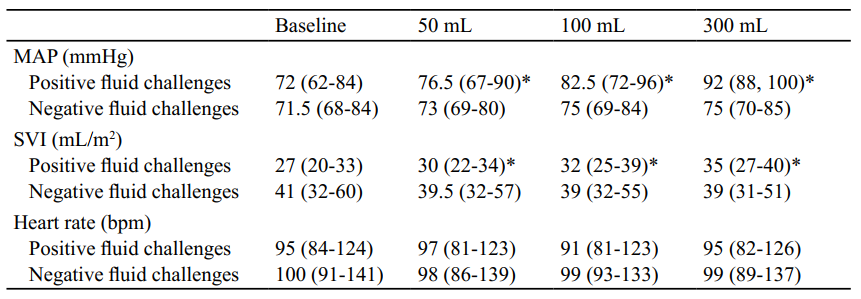PREDICTION OF FLUID RESPONSIVENESS WITH CRYSTALLOID MINI-FLUID CHALLENGE IN CRITICALLY ILL PATIENTS
DOI:
https://doi.org/10.55374/jseamed.v8.190Keywords:
crystalloid, mini-fluid challenge test, fluid responsiveness, septic shockAbstract
Background: The mini-fluid challenge test is a good predictor and has minimal limitations in determining fluid responsiveness in the critically ill. However, it primarily relies on colloid infusion. The availability of colloids may vary among hospitals in resource-limited countries, and they can be more expensive than crystalloid fluids.
Objective: The study aimed to use crystalloids instead of colloids to predict fluid responsiveness.
Methods: This study was conducted from August 2022 to February 2023 among patients with shock in the medical ICU to assess fluid responsiveness. Arterial and central venous catheters were used for the intravenous infusion and monitoring. Data were collected during two consecutive crystalloid mini-fluid challenges of 50 mL each in 1 minute, 100 mL in 2 minutes, and a standard fluid challenge of 300 mL over 15 minutes. The objective was to predict a stroke volume index (SVI) increase of > 10%. Diagnostic accuracy was evaluated using the Receiver Operating Characteristic (ROC) curve, and hemodynamic variables in the positive fluid challenge group were compared for different volume expansions.
Results: Twenty-nine patients (62% males; median age, 75 years) were included, with 42 fluid challenge test events. Septic shock was the primary condition in 83% of the cases. The 50 mL crystalloid mini-fluid challenge showed an accuracy of 80% with a sensitivity of 69% and specificity of 100% at the cutoff level of SVI > 5%, Area Under ROC (AUROC)=0.79. In comparison, the 100 mL crystalloid mini-fluid challenge demonstrated an accuracy of 85% (sensitivity of 79% and specificity of 100%) at the cutoff level of SVI > 10% (AUROC= 0.89). In the positive fluid challenge group, administration of crystalloids led to a significant increase in mean arterial pressure and SVI, while other parameters remained comparable.
Conclusions: A mini-fluid challenge test with 100 mL crystalloids can predict fluid responsiveness in critically ill patients. The best cutoff level was a change in SVI > 10% from baseline.
Downloads
Metrics
References
Vincent JL, Fink MP, Moore FA, Kochanek P, Vincent JL, Abraham E. Textbook of critical care. 7th edition. Philadelphia, PA: Elsevier; 2017.
Messina A, Palandri C, De Rosa S, Danzi V, Bonaldi E, Montagnini C, et al. Pharmacodynamic analysis of a fluid challenge with 4 ml kg(-1) over 10 or 20 min: a multicenter crossover randomized clinical trial. J Clin Monit Comput 2022; 36: 1193-203. https://doi.org/10.1007/s10877-021-00756-3
Rhee C, Jones TM, Hamad Y, Pande A, Varon J, O'Brien C, et al. Prevalence, underlying causes,and preventability of sepsis-associated mortality in US acute care hospitals. JAMA Netw Open 2019; 2: e187571. https://doi.org/10.1001/jamanetworkopen.2018.7571
Hansen B. Fluid Overload. Front Vet Sci 2021; 8: 668688. https://doi.org/10.3389/fvets.2021.668688
Marik PE, Lemson J. Fluid responsiveness: an evolution of our understanding. Br J Anaesth 2014; 112: 617-20. https://doi.org/10.1093/bja/aet590
Vincent JL, Cecconi M, De Backer D. The fluid challenge. Crit Care 2020; 24: 703. https://doi.org/10.1186/s13054-020-03443-y
Monnet X, Shi R, Teboul JL. Prediction of fluid responsiveness. What's new? Ann Intensive Care 2022; 12: 46. https://doi.org/10.1186/s13613-022-01022-8
Enev R, Krastev P, Abedinov F. Prediction of fluid responsiveness: a review, Biotechnol Biotechnol Equip 2021; 35: 1147-55. https://doi.org/10.1080/13102818.2021.1960190
Toscani L, Aya HD, Antonakaki D, Bastoni D, Watson X, Arulkumaran N, et al. What is the impact of the fluid challenge technique on diagnosis of fluid responsiveness? A systematic review and meta-analysis. Crit Care 2017; 21: 207. https://doi.org/10.1186/s13054-017-1796-9
Muller L, Toumi M, Bousquet PJ, Riu-Poulenc B, Louart G, Candela D, et al. An increase in aortic blood flow after an infusion of 100 ml colloid over 1 minute can predict fluid responsiveness: the mini-fluid challenge study. Anesthesiol 2011; 115: 541-7. https://doi.org/10.1097/ALN.0b013e318229a500
Marik PE, Cavallazzi R, Vasu T, Hirani A. Dynamic changes in arterial waveform derived variables and fluid responsiveness in mechanically ventilated patients: a systematic review of the literature. Crit Care Med 2009; 37: 2642-7. https://doi.org/10.1097/CCM.0b013e3181a590da
Messina A, Dell'Anna A, Baggiani M, Torrini F, Maresca GM, Bennett V, et al. Functional hemodynamic tests: a systematic review and a metanalysis on the reliability of the end-expiratory occlusion test and of the mini-fluid challenge in predicting fluid responsiveness. Crit Care 2019; 23: 264. https://doi.org/10.1186/s13054-019-2545-z
Biais M, de Courson H, Lanchon R, Pereira B, Bardonneau G, Griton M, et al. Mini-fluid challenge of 100 ml of crystalloid predicts fluid responsiveness in the operating room. Anesthesiol 2017; 127: 450-6. https://doi.org/10.1097/ALN.0000000000001753
Guinot PG, Bernard E, Defrancq F, Petiot S, Majoub Y, Dupont H, et al. Mini-fluid challenge predicts fluid responsiveness during spontaneous breathing under spinal anaesthesia: An observational study. Eur J Anaesthesiol 2015; 32: 645-9. https://doi.org/10.1097/EJA.0000000000000175
Lee CT, Lee TS, Chiu CT, Teng HC, Cheng HL, Wu CY. Mini-fluid challenge test predicts stroke volume and arterial pressure fluid responsiveness during spine surgery in prone position: A STARD-compliant diagnostic accuracy study. Medicine (Baltimore) 2020; 99: e19031. https://doi.org/10.1097/MD.0000000000019031
Pan Y, Bai W, Chen J, Mao Y, Qian X, Xu K, et al. Diagnosing malignant pleural effusion using clinical and analytical parameters. J Clin Lab Anal 2019; 33: e22689. https://doi.org/10.1002/jcla.22689

Downloads
Additional Files
Published
How to Cite
Issue
Section
License
Copyright (c) 2024 Journal of Southeast Asian Medical Research

This work is licensed under a Creative Commons Attribution-NonCommercial-NoDerivatives 4.0 International License.
The Journal of Southeast Asian Medical Research will hold the copyright to all published articles. The publisher's production department handles copyright forms once a manuscript is accepted and scheduled for publication.







